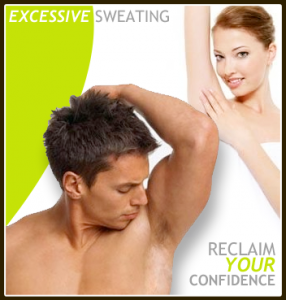Hyperhidrosis Excessive
Hyperhidrosis Excessive Sweating/Perspiration

Quick Facts
- Hyperhidrosis is defined as sweating in excess of the normal needs of the body
- There can be underlying medical problems causing this in some cases, and it needs to be investigated by a doctor
- There are a number of treatments for hyperhidrosis
- Aluminium chloride (topical medication)
- Iontophoresis – regular treatments, placing affected area in electrically charged water/sodium glycopyrrolate
- Medication – suited to those who sweat in several areas
- Anti-wrinkle injections – injections used normally for facial wrinkles can be injected in areas such as the underarms/hands/feet. The average duration of effect is 8 months
- Endoscopic thoracic sympathectomy (surgery) – but this can have the effect of compensatory sweating elsewhere after the surgery is performed.
What is Hyperhidrosis?
Hyperhidrosis is a condition that is characterised by sweating or perspiration in excess of the normal needs of the body.
It is classified as either primary or secondary hyperhidrosis. Primary hyperhidrosis is not due to any particular underlying reason, and can result in excessive sweating in the palms, feet, underarms, face and scalp. There is usually an associated family history. Sweating usually affects both sides, and is less at night than during the day. Secondary hyperhidrosis is a result of an underlying medical condition such as infection, endocrine disorders, metabolic disorders, neoplastic diseases, neurological conditions, spinal cord injuries, cardiovascular disorders, respiratory disorders, anxiety and stress. The treatment of secondary hyperhidrosis will require treatment of the underlying problem or cause.
The rates of primary hyperhidrosis are estimated at 3% of the population, the age group most affected is from 18 to 54 years.
How can Hyperhidrosis be treated?
Primary hyperhidrosis can be treated with topical treatments, iontophoresis, oral medication (anti-cholinergics), anti-wrinkle injections (due to TGA restrictions, the actual name of these ‘anti-wrinkle injections’ cannot be named, but is a common treatment for facial wrinkles also used to stop sweating when injected into the area of excessive sweating), and finally, surgery. The treatment of secondary hyperhidrosis will require treatment of the underlying problem or cause. Usually, treatment is commenced with the least invasive measures and then progress if there is not sufficient improvement.
Anti-perspirants are usually the first line of treatment for underarm and palm sweating, but are not as useful in other areas. Driclor, a brand of aluminium chloride, blocks sweat glands and eventually destroys them. It is usually applied at night and washed off in the morning. In the long term, it can be used less frequently as sweating decreases. Irritation is a common side effect, and may often require the use of hydrocortisone 1% to reduce this. Driclor is available over the counter.
Another method of non-invasively treating hyperhidrosis is by using anti-cholinergic medication. Anti-cholinergics affect the part of the autonomic nervous system, which is the nervous system for unconscious functions, and help to reduce sweating. It is not completely selective for sweating, and also tends to affect other parts of the autonomic nervous system leading to dry mouth, constipation, urinary retention, and blurred vision. An example of a commonly used anti-cholinergic is Probanthine. The advantage of anti-cholinergics is that it can treat sweating in any area. A script can be written by your local doctor or the doctors at MPM Aesthetic Medicals.
Iontophoresis is an effective means of reducing sweating. It involves the use of a electrically charged current that is run through tap water with or without the addition sodium glycopyrrolate in the water. The hands, feet and sometimes the underarm area is put in this electrically charged water. The mechanism of action is not definitively known. Frequent sessions are required initially, until the sweating is controlled, and then regular maintenance sessions are required to keep this improvement continuing. Iontophoresis is also used with glycopyrrolate solution which is an anti-cholinergic medication. The electrical charge increases the uptake of the glycopyrrolate into the treatment area and this helps to stop sweating for a longer period than plain water alone.
Anti-wrinkle injections, normally used to help reduce the wrinkles on the face can also work to stop sweating. Anti-wrinkle injections have been widely used for the treatment of hyperhidrosis, especially in the underarms, face and scalp. It can also be used in the palms and feet, but is very painful to inject in this area and may require some form of sedation/anaesthetic . The underarms/scalp don’t tend to be too painful and can often be done with just local anaesthetic cream. Anti-wrinkle injections work by stopping the nerve signal to the sweat glands in the area it is injected into. The underarms are the most common area treated by anti-wrinkle injections. Usually 100 units are used for this area. For feet and hands, 100-200 units are required to do both the right and left sides. Alternately, only the right hand or dominant hand can be treated and with 50 to 100 units.
After application of anaesthetic cream, Minor’s starch-iodine test is performed. This involves putting iodine on the area to be treated and allowing the area to sweat for a while. Starch is placed on the area and the sweaty areas highlight in black. These areas are then treated with the injections.
The hands can also be treated, and often only the dominant hand is treated (to avoid a wet hand shake). The dosage is variable in the hands, but usually requires around 50-100 units per hand. The face or scalp can be treated for excessive sweating with anti-wrinkle injections. There is the possibility that it will affect the muscles of facial expression also, and this may lead to unwanted changes in the muscles. The dosage for the face/scalp will depend on the size of the area treated. Feet are very difficult to treat with, anti-wrinkle injections and can often be unresponsive to even larger doses. The main difficulty with the treatment of feet with anti-wrinkle injections is the sensitivity of this area to injections and sedation may be required to do the procedure. This treatment is commonly performed at MPM Aesthetic Medicals by our doctors.
Facial sweating can also be treated. Anti-wrinkle injections can be used in some areas, but because they also relax the muscles of facial expression, they cannot be used in all areas as they may affect one’s ability to express normally. They are effective for areas such as the upper lip and forehead in particular, and may have the added benefit here of reducing wrinkles in these areas if present. Alternately, topical agents can be used for facial sweating. We commonly recommend topical glycopyrrolate gel, which usually lasts for about 3 days with each application.
Endoscopic thoracic sympathectomy is usually the final step in improving hyperhidrosis. By surgically disrupting the nerves that cause sweating (the sympathetic nervous system), this procedure is able to reduce sweating in the upper limbs, feet, or underarms. This part of the nervous system is also responsible for other functions such as the size of the pupil, opening the eyelids, hence this surgery can also disrupt these functions. Furthermore, compensatory sweating may occur in the areas that have not been treated. This treatment is not performed at MPM Aesthetic Medicals.

